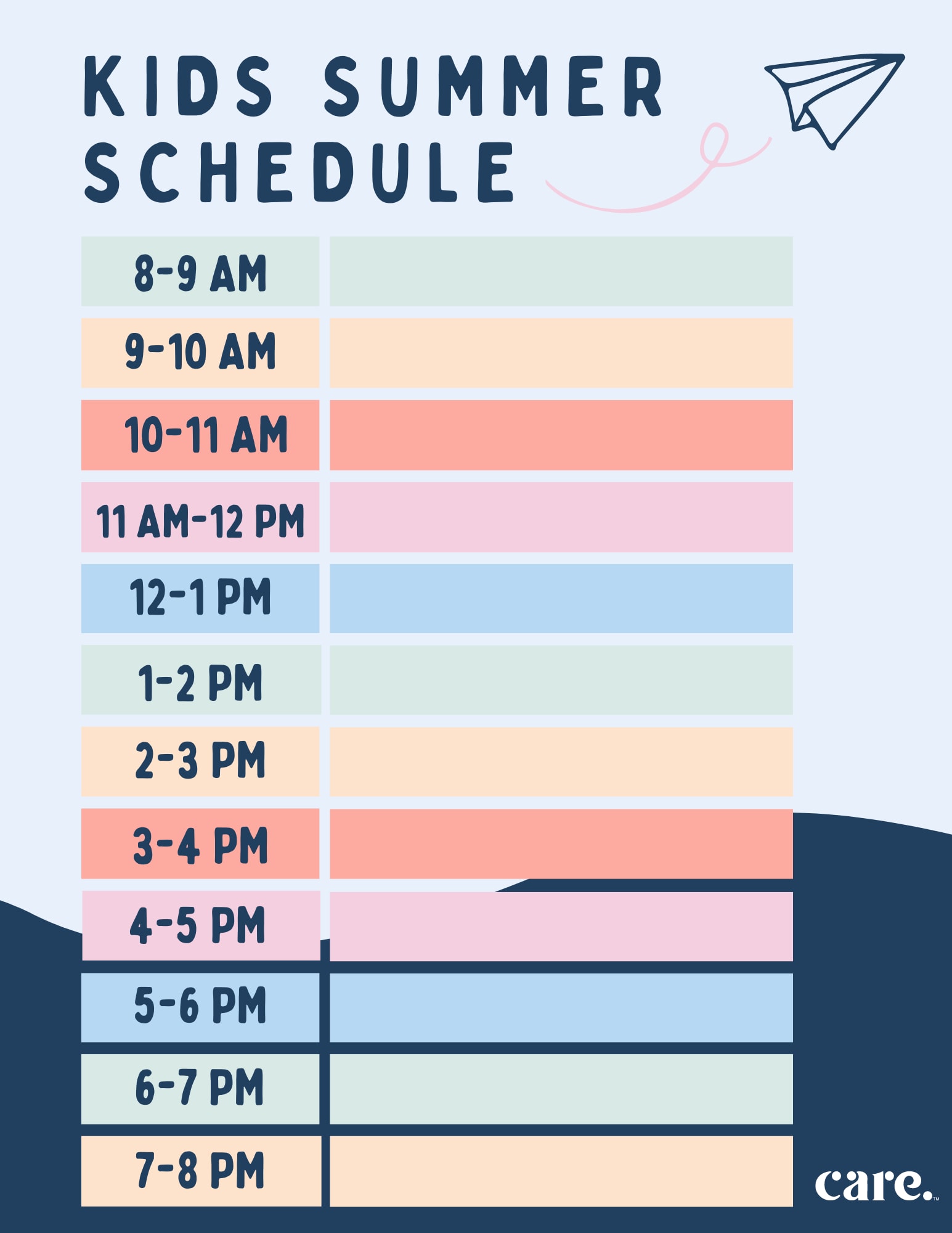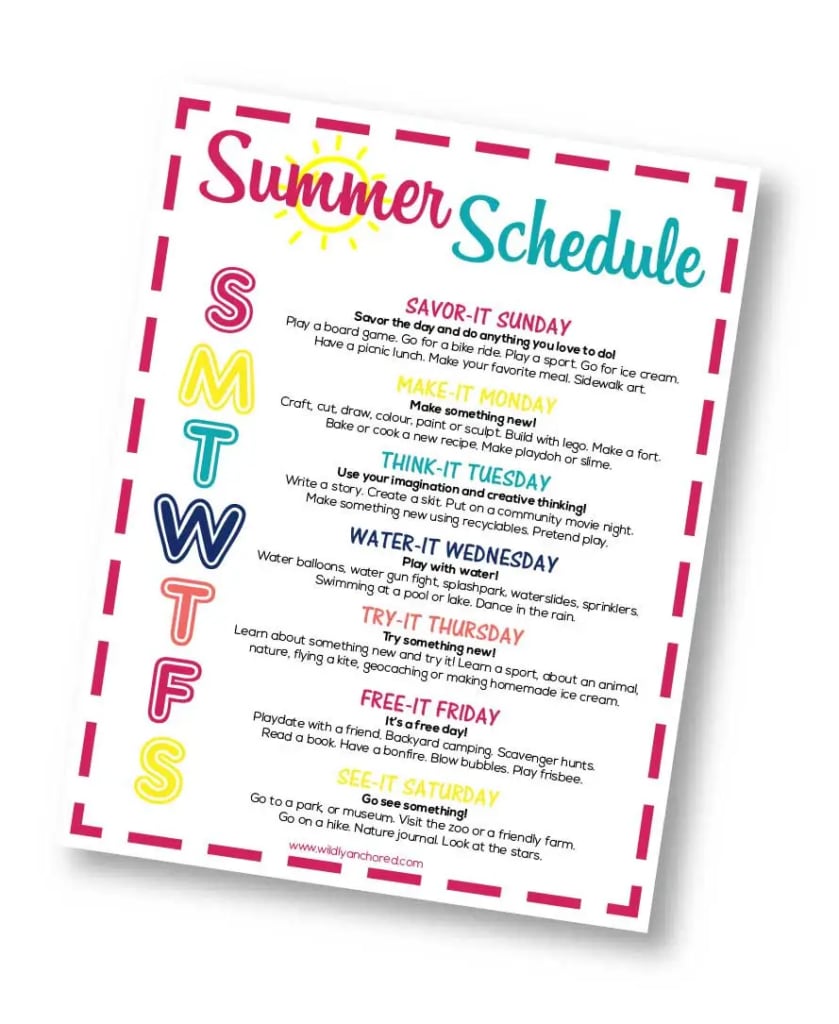Kids (and their parents and caregivers) wait all year long for these long, sunny days, but it’s usually only a matter of time before the “I’m bored” chorus begins. This year, why not squash it before it starts by implementing a summer schedule?
You’ve probably seen examples on Pinterest or Instagram. They’re often colorful and stuffed to the brim with activities. We know what you’re thinking: “Oh no, do I have to come up with activities?” Luckily, creating a boredom-busting summer schedule for kids is actually pretty easy.
Here are six examples of summer routines for kids from real parents and caregivers, as well as expert advice on how to build your own.
Why do I need a summer schedule for kids?
There are a lot of good reasons to stick to a summer schedule for your kid. One major benefit is that it can help prevent the so-called summer slide. Research shows that kids can lose between 17-34% of the year’s prior learning during the summer. Keeping kids in a routine, particularly if that routine includes consistent opportunities for learning and play, can help them keep learning all season long.
A good summer schedule or routine can also help kids stay active and prevent stress and anxiety. “Children of all ages (and even adults) thrive on routines and structure,” says Allison Wilson, an early childhood educator and the Senior Director of Curriculum and Innovation at Stratford School.
So, what should be included in a kids summer schedule?
Even though we can all benefit from some sort of schedule or routine, how that looks may be different for each child, caregiver and family.
“Some kids thrive by being creatures of habit with a more regimented schedule, while other kids love the flexibility of an on-a-whim, spur-of-the moment type of day,” says Donna Whittaker, a veteran early childhood educator and Vice President of Curriculum and Education at Big Blue Marble Academy.
Here are the main categories to consider when creating your own summer schedule for kids.
- Essential daily tasks: Getting dressed, brushing teeth, doing chores — you can decide how detailed to get.
- Reading time: “Check out your local library summer reading programs or story time,” Wilson advises.
- Educational fun: Whittaker recommends cooking a recipe together to build literacy and math skills, a backyard fort to help with problem solving or jumping rope to build fine motor skills.
- Opportunities for exploration: “Summer is a great time to explore your local community or perhaps somewhere out of the area,” Wilson says.
- Playtime: “Power off the devices and play, sing, be silly, go on walks and bike rides, enjoy picnic lunches, play ball in the backyard, and lay on a blanket after dark to look for shooting stars and catch fireflies all together,” Whittaker says.
Downloadable summer schedule for kids (free printable)
Create a summer schedule for kids and set up a perfect routine that includes their daily tasks, meals, reading and educational fun and playtime. It’s super simple with this free printable.

(Click to download this summer schedule for kids template as a PDF.)
A sample summer schedule for kids
Your summer schedule will change based on your lifestyle, needs and what kids enjoy. “Some children require more scaffolding when it comes to accomplishing tasks, while others may rebel against the checklist method and be able to accomplish tasks without it,” says Whittaker. “Getting their input on schedules will help them to feel in control and powerful.”
Here’s a sample schedule for summer to help you get started:
| Time | Summer activity |
| 8:30-9:00 a.m. | Wake up, get dressed and brush teeth. |
| 9:00-10:00 a.m. | Make breakfast together. |
| 10:00-10:30 a.m. | Chore time: Make your bed, pick up toys, tidy up. |
| 10:30-11:00 a.m. | Reading time. |
| 11:00-12:30 p.m. | Creative time: Art activity or creative play. |
| 12:30-1:30 p.m. | Eat lunch. |
| 1:30-3:30 p.m. | Screen-free playtime or outside time. |
| 3:30-5:00 p.m. | Free time. |
| 5:00-6:00 p.m. | Dinner and bath time. |
6 more useful and fun summer schedules for inspiration
Ready for some inspiration as you create a summer schedule for your kids? Here’s a look at the routines, charts and checklists that have helped other parents and caregivers get set up for success.
1. Time for work and for play
In her daily summer checklist for kids, Steph of A Grande Life combines structured routine with plenty of opportunities for play, adventure and relaxation. Color-coded chores help kids know what to focus on each morning. There’s also a block for a designated summer activity or just to simply go outside. Rounding out the day are blocks for quiet time and a very important nightly shower to rinse away the day.

2. First things first
For her kids’ summer schedule, Gator Mom divided each day’s tasks into “must-dos” and activities to choose from after all of the musts are completed. This helps kids prioritize tasks they need to tackle before they relax and have fun. It also helps pace natural limits on screen-time without being too rigid.

3. Check it off the to-do list
This printable summer chore chart from The Incremental Mama is straightforward but still offers kids a lot of freedom and flexibility. They have blocks for self-guided reading time, outdoor play and creative time. Combined with very simple daily chores, this schedule offers structure without rigidity.

4. Rock around the clock
For kids who crave extra structure, this printable summer schedule from Mighty Mrs. lays out activities on a timeline from sun-up to bedtime. The schedule incorporates reading, summer chores, educational workbooks and arts and crafts. It could be a great day-to-day guide for nannies, parents and grandparents alike.

5. Stick with the theme
For an easy-breezy approach to your summer routine, consider this loosely outlined daily summer plan from Wildly Anchored. Rather than specific activities or times, each day is given a theme and a list of corresponding ideas for things to do, make or try. For example, Try-It Thursday is all about researching things that interest kids and trying something brand new. It will keep kids engaged in new things every week.

6. Take it one thing at a time
Break up the day into manageable chunks using this printable kids schedule from House Mix. Activities are grouped into categories for the morning, afternoon and evening, with loose times to keep the day flowing without too much stress. Pictures along with words also make this a great schedule for kids of varying ages.

The bottom line on finding the ultimate summer schedule for your kids
No matter which seasonal schedule suits your child, implementing one has both short- and long-term benefits. As Wilson puts it, “Routines help children to know what to expect and can provide opportunities to build self-help skills and independence.”






